Californians’ Attitudes About College Access, Affordability, and Equity in the Time of COVID-19

Summary
The 2021 PACE/USC Rossier poll provides key insights into Californians’ perceptions of higher education issues during the COVID-19 pandemic, specifically equity and affordability. A large percentage of Californians acknowledge that college affordability is an important educational issue, and they generally express support for increased access to courses through remote options, increased funding for community colleges, loan forgiveness, and equitable admissions practices. However, public opinion on these issues is more nuanced; for example, Californians are concerned that increased access to educational opportunities could compromise the quality of higher education, and they believe that universities should consider only academic and extracurricular qualifications in admissions to college, not race or income. There are important differences in perceptions of these higher education issues across the lines of political affiliation and race.
Introduction
The COVID-19 pandemic has created new challenges and exacerbated persisting inequities in education for historically underserved students of color.1 Nationally, higher education enrollment fell to 16.9 million from 17.5 million this spring, “marking a one-year decline of 3.5 percent or 603,000 students, seven times worse than the decline a year earlier.”2 Community colleges and private for-profit four-year institutions felt the most impact, with low-income students disproportionately experiencing enrollment disruptions or delays in college participation. In California, enrollment in community college dropped precipitously in fall 2020: The total number of enrolled students fell by 12 percent relative to the prior year.3 There were large enrollment decreases in all racial and ethnic groups, but Black, Native American, and Latinx students experienced the largest declines. Male students, older students, and new students also had disproportionately high declines.4 Enrollment losses were felt throughout the entire community college system, with more substantial declines in some regions across the state.5
Remedying these educational inequities in the wake of the COVID-19 pandemic will require investments to improve access and make college more affordable. To this end, at the federal level, the American Rescue Plan Act of 2021 allocated “nearly $40 billion to institutions of higher education and college students.”6 At the state level, Governor Newsom signed Assembly Bill 132, the California Comeback Plan, which allocates $47.1 billion to the three systems of higher education.7 These new resources come at a time of unprecedented change in the higher education system. Colleges and universities made a tremendous transition to remote instruction in the midst of the pandemic; whether and in what form remote offerings will continue to be a feature of degree programs across public colleges and universities remains to be seen. In addition, there have been substantial policy changes aimed at making college admissions more equitable to increase access to higher education for all students. The pandemic led to the dismissal of standardized testing in more than half of colleges and universities across the nation for fall 2021 admission.8 For fall 2022 admission, more than two thirds of four-year colleges and universities will not require SAT/ACT scores.9 The majority of these colleges and universities have chosen to remain test optional, largely influenced by the pandemic, but the University of California Board of Regents voted to remove the SAT/ACT requirement altogether.10
The long-term success of these initiatives will depend on the support of California’s students, families, and voters at large. To that end, this brief provides some information about the public’s views on college affordability and access from the 2021 PACE/USC Rossier annual poll, with the goal of informing the implementation and refinement of current and future state policies aimed at addressing the inequities in education that the COVID-19 pandemic has exacerbated.
1. College Affordability Is a Top Priority for Californians
When asked to rank the importance of various educational issues, California voters rank college affordability as the second most important educational issue facing the state, following reducing gun violence in schools (see Figure 1). Voters were presented with various educational issues and were asked to indicate the importance of each, with a rating of 1 meaning “not at all important” and a rating of 10 meaning “very important.” Overall, “reducing gun violence in schools” was ranked the highest priority, with 53 percent of voters rating it a 10 and 31 percent of voters rating it 6–9, compared with 41 percent of voters rating “making college more affordable” a 10 and 42 percent of voters rating it 6–9. In addition, “increasing the number of students who finish college” ranked sixth overall, with 32 percent of California voters rating it a 10 and 48 percent of voters rating it 6–9.
Figure 1. Most Important Educational Priorities, With Rating of 10 as Highest Level of Importance
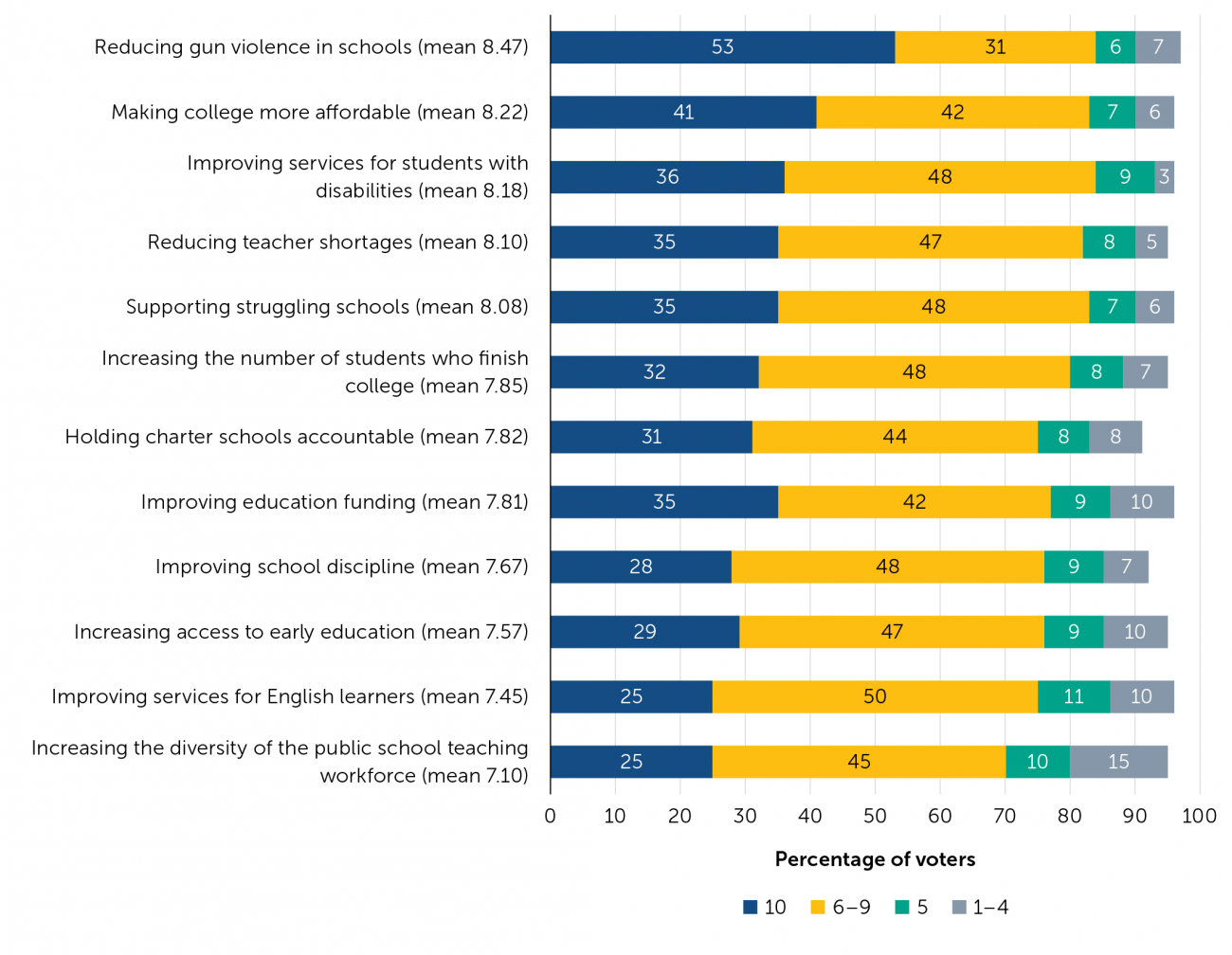
Note. "Don't know" responses are not reported here.
On the issue of college affordability, there are important differences by political party, demographics, and income level (see Figure 2).11 More than half of Black voters (63 percent) rank this issue as “very important,” compared with 49 percent of Latinx voters, 37 percent of White voters, and 29 percent of Asian American voters. About half of Democrats (51 percent) rank this issue as “very important,” compared with 31 percent of Republican voters. In addition, there are some stark differences by political affiliation observed by race/ethnicity. About 47 percent of White Democrats rank college affordability as a “very important” issue, compared with 26 percent of White Republicans. We also found differences by gender, with more women (47 percent) ranking this issue “very important” than men (34 percent), and even larger differences were observed by age, with 28 percent of older12 men ranking this issue as “very important,” compared with 46 percent of older women. Differences varied by income level as well, with a clear pattern of decreasing support for college affordability at higher income levels; more than half of voters making less than $35,000 rank this issue as “very important,” compared with only 13 percent of voters making $500,000 or more. Results on this question are consistent with prior years’ reporting. Our findings also align with nationwide trends of Democrats’ higher support for improving college affordability than Republicans’ support; for example, nationally, 46 percent of Democrats strongly support “free tuition at all public colleges and universities,” compared with 15 percent of Republicans, and 54 percent of Democrats strongly support “free tuition at community colleges,” compared with 19 percent of Republicans.13
Figure 2. Importance of College Affordability by Political Party, Race/Ethnicity, and Income Level
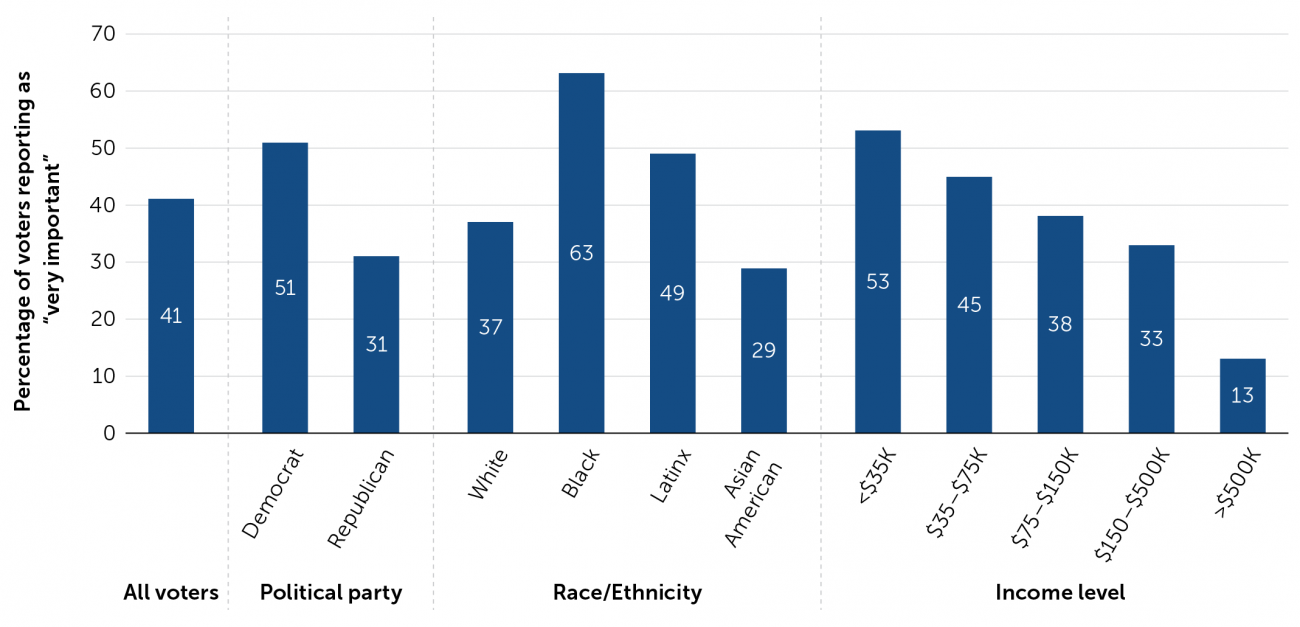
Racial inequalities in college access are important for considering the issue of college affordability. Research has shown that substantial disparities in college enrollment exist by student racial/ethnic group; for example, while 18 percent of Asian American high school students go on to attend University of California institutions, only 4 percent of Latinx and 3 percent of Black students do the same.14 Recent reports have been critical of the state’s underinvestment in higher education funding for Black students given their disproportionate enrollment in institutions that receive less funding than the University of California system.15 Moreover, despite the importance of college affordability, newly proposed tuition increases across the nine University of California campuses for students starting college in fall 202216 and lack of Cal Grant reform in financial aid17 could exacerbate these inequalities. Efforts to reform and expand financial aid are critical given the disparate impacts of affordability and degree attainment by race/ethnicity, income, and region.18
2. Californians Support Loan Forgiveness
At the national level, there have been important policy discussions on forgiving federal student loan debt for individual borrowers.19 A large majority (63 percent) of California voters support some level of loan forgiveness, to varying degrees.20 However, about a quarter of voters (26 percent) believe that “the federal government should not forgive any student loan debt,” with more than half of Republicans expressing this view (51 percent), compared with Democrats (11 percent), as shown in Figure 3. Voters age 50 and older are less supportive of loan forgiveness (40 percent) than voters younger than age 50 (14 percent). We also note differences in levels of lack of support for loan forgiveness among California voters in different racial and ethnic groups: 33 percent of White voters do not support loan forgiveness, compared with 25 percent of Asian American voters, 20 percent of Black voters, and 13 percent of Latinx voters. Voters who do not have children at home are twice as less likely to support loan forgiveness (30 percent) than those who do have children at home (15 percent).21
Figure 3. Percentage of Voters Not Supporting Loan Forgiveness by Political Party, Race/Ethnicity, and Age

Californians’ Attitudes About College Access, Affordability, and Equity in the Time of COVID-196 During the COVID-19 pandemic, the Coronavirus Aid, Relief, and Economic Security Act of 2020 (also known as the CARES Act) provided some financial relief for students by halting payments for federal student loans. This is important given that students are more likely to take out loans now than in prior years.22 Moreover, recent efforts to highlight inequality in wealth by race underscore the racial wealth gap that exists between White and Black students. Since Black students are more likely to pay for their education by accumulating debt, it is critical to ensure that obtaining a college degree improves economic mobility rather than limits it.23
3. Californians Support Increasing Resources for Attending Community College
Community colleges serve as a critical point of access for more than half of California high school students entering college.24 Initiatives like the California Promise program and the California College Promise Grant aim to increase college affordability for eligible students at community colleges by waiving enrollment and tuition fees,25 but these initiatives may not fully support the financial costs of attending college for many students, which include housing and living expenses. This has important implications for socioeconomically disadvantaged students and students of color, given that many of these students are more likely to enroll in community colleges.26 As shown in Figure 4, Californians overwhelmingly support increasing state funding to cover the full costs of college, specifically “providing more funding for housing or living expenses so more students can enroll in community college programs” (71 percent). More specifically, 36 percent strongly support this statement, while only 8 percent strongly oppose the statement. There are differences in support levels based on political affiliation and racial group: 84 percent of Democrats support increased community college funding, while only 54 percent of Republicans and 64 percent of Independents do, and Whites have lower levels of support than all other racial/ethnic groups.
Figure 4. Percentage of Voters Supporting More Community College Funding for Housing and Living Expenses by Political Party and Race/Ethnicity27
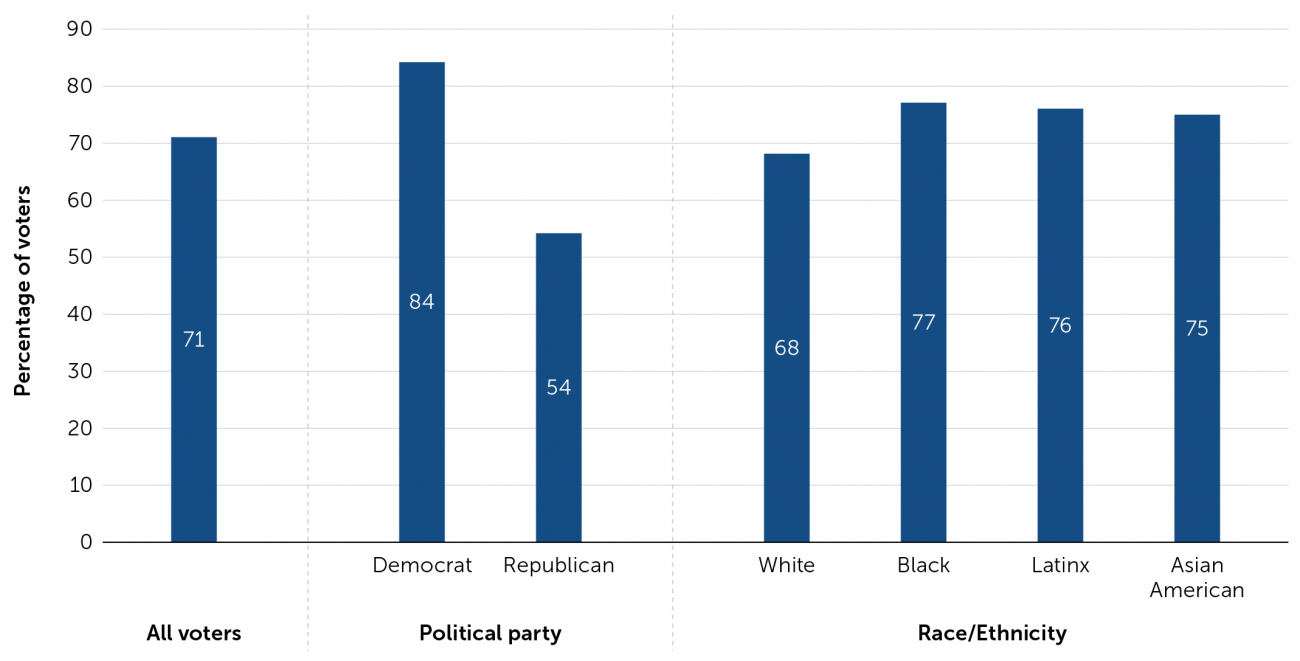
4. The Majority of Voters Support Expansion of Online College Offerings to Increase Access
The COVID-19 pandemic resulted in a necessary shift to remote instruction for California’s colleges and universities. When asked whether “making more courses available online in California’s public colleges and universities will expand opportunities for young people in our state,” the majority of voters (76 percent) agree that college courses should be offered online, with 81 percent of Democrats agreeing with this statement, compared with 66 percent of Republicans (see Figure 5).28 Although a majority of voters agree that online courses would expand opportunities, half of California voters also believe that “making more courses available online will reduce the quality of teaching and learning in California’s public colleges and universities.”
Figure 5. Agreement With Statements About Access, Quality, and Cost of Online Courses
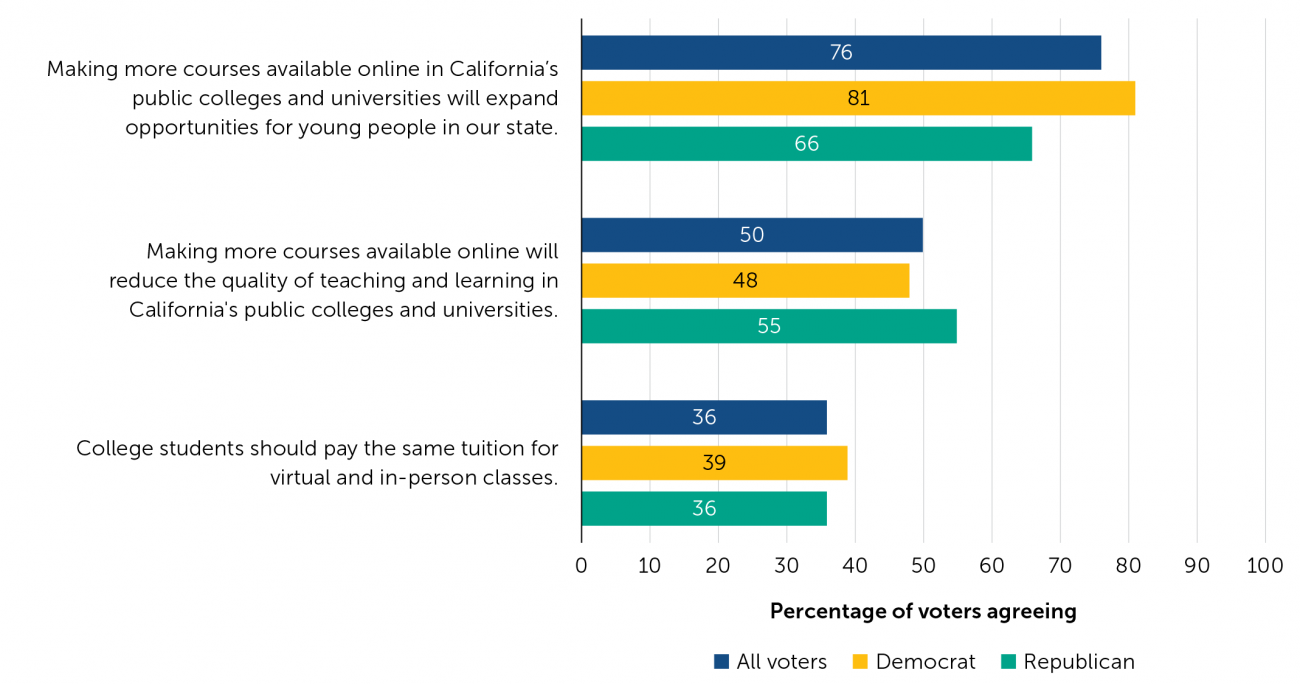
This tension that exists between access and quality in online postsecondary options has important implications for higher education institutions when making programmatic decisions about maintaining and/or expanding online learning options during postpandemic recovery efforts. Recent reports suggest that the California State University system is considering keeping online options to meet the needs of students who may have family responsibilities or work obligations that may be better accommodated with more flexible options.29 Similarly, the community college sector is rethinking education initiatives such as HyFlex (a teaching model that requires faculty to teach courses in different modalities: in person, online, and asynchronously). Although these efforts can certainly increase college access and accommodate more students’ needs, there are concerns about the drastically varied educational experiences that students can have across these modalities and their impacts on academic success.
Moreover, the move to remote instruction exacerbated existing inequities in access to high-speed internet across the state, magnifying the digital divide that affects many minoritized communities.30 A study conducted by the California Student Aid Commission and the California Education Lab at the University of California, Davis, found that about 62 percent of students had unreliable internet connections and about 44 percent did not have access to the material for their online courses when enrolled remotely in fall 2020.31 These challenges were more pronounced for Black, Latinx, low-income, and community college students.32
5. Admissions Criteria at Four-Year Universities Remain Controversial
Only a small number (17 percent) of respondents believe that “universities should be allowed to use race to make admissions decisions to ensure a diverse student body and because of discrimination against certain racial groups.”33 Another 19 percent of respondents agree that “instead of race, universities should use a family’s socioeconomic and financial status to get a diverse student body.” And approximately half of respondents (52 percent) believe that “universities should only use academic and extracurricular qualifications in assessing student admissions and not use race, ethnicity, or socioeconomic status.” Although the majority of all respondents support using academic and extracurricular qualifications only, Democrats (24 percent) are more likely to support universities using race than Republicans (9 percent). Overall, the percentage of respondents who chose each factor (race, socioeconomic status, and academic/extracurricular qualifications) did not change much since we last asked this question in our annual poll in 2019.34
All racial/ethnic groups were more likely to indicate that academic/extracurricular qualifications be the primary factor in admissions. When asked whether race should be considered in admissions, there were differences across racial/ethnic groups: 30 percent of Black respondents, 20 percent of Latinx respondents, 15 percent of White respondents, and 21 percent of Asian American respondents indicated support (see Figure 6).
Figure 6. Voters’ Preferred Admissions Criteria in 2021 by Race/Ethnicity
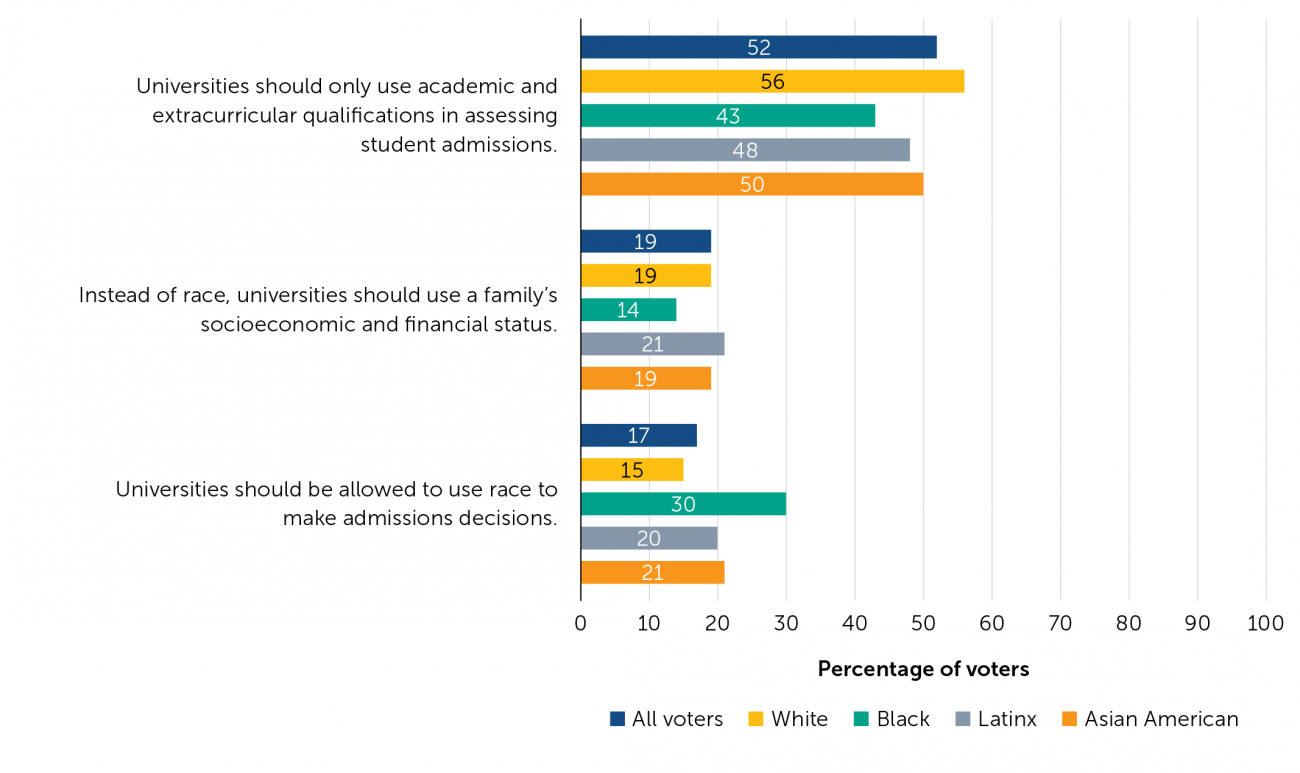
Note. "Don't know" responses are not reported here.
When asked whether “removing standardized tests from admissions decisions at California’s public universities has made the process more fair for students,” about half of voters (51 percent) agree while 36 percent disagree (see Figure 7).35 There are important differences by political party and age: 65 percent of Democrats agree with this statement, compared with 35 percent of Republicans. Voters under the age of 50 are more likely to agree (63 percent) than voters age 50 and older (37 percent). There are also some differences by race/ethnicity, with 59 percent of Black and Latinx voters agreeing to this statement, compared with 46 percent of Asian American voters and 47 percent of White voters.
Figure 7. Voters’ Perspectives on the Impact of Removal of Standardized Testing on Fairness by Political Party, Race/Ethnicity, and Age
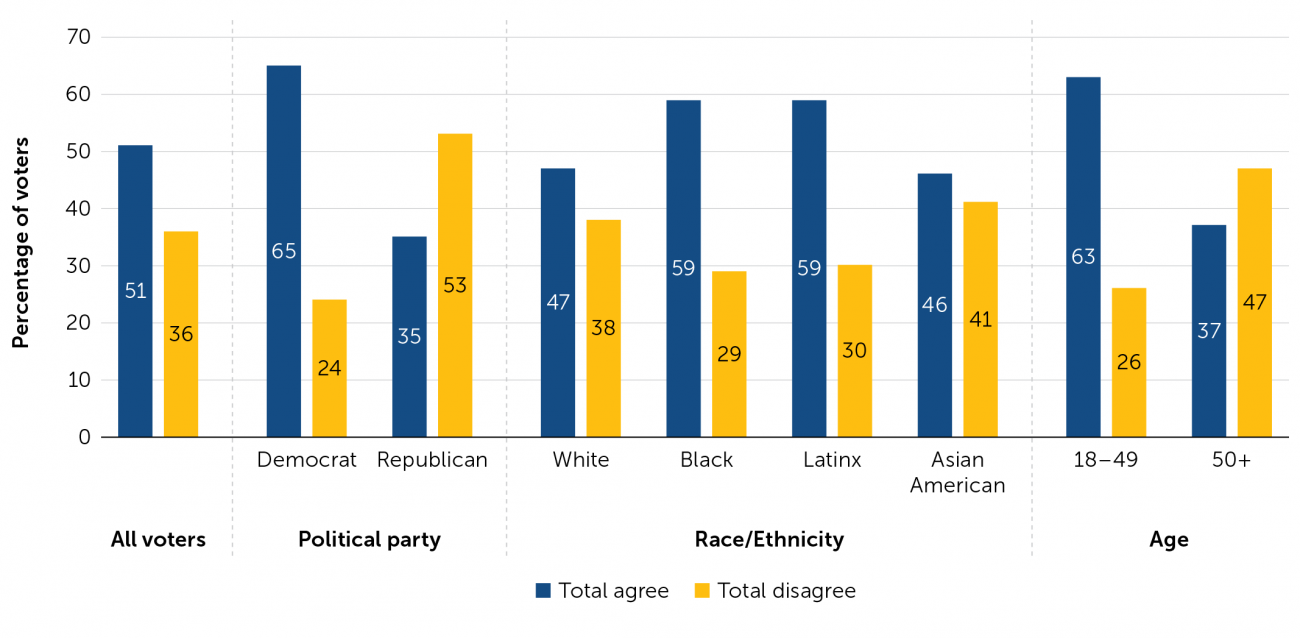
Note. "Don't know" responses are not reported here.
Given that more than half of voters (52 percent) support using only academic/extracurricular qualifications for admissions, it is interesting to note whether this group, in particular, has differing views on whether “removing standardized tests from admissions decisions at California’s public universities has made the process more fair for students.” Figure 8 shows that 43 percent of the voters who support using only academic/extracurricular qualifications for admissions agree that removing standardized tests made the process more fair for students and 46 percent disagree (11 percent report “Don’t know”).36 Among respondents who do support consideration of race in admissions, 71 percent believe that removing standardized tests has made the process more fair; results are more mixed among the respondents who support consideration of the family’s socioeconomic status. Thus, although a large majority of voters believe that removing standardized tests has made college admissions more fair, this perspective is less widely held among respondents who support only the use of academic and extracurricular qualifications for admissions.
Figure 8. Voters’ Perspectives on Fairness in Admissions and the Impact of Removing Standardized Testing
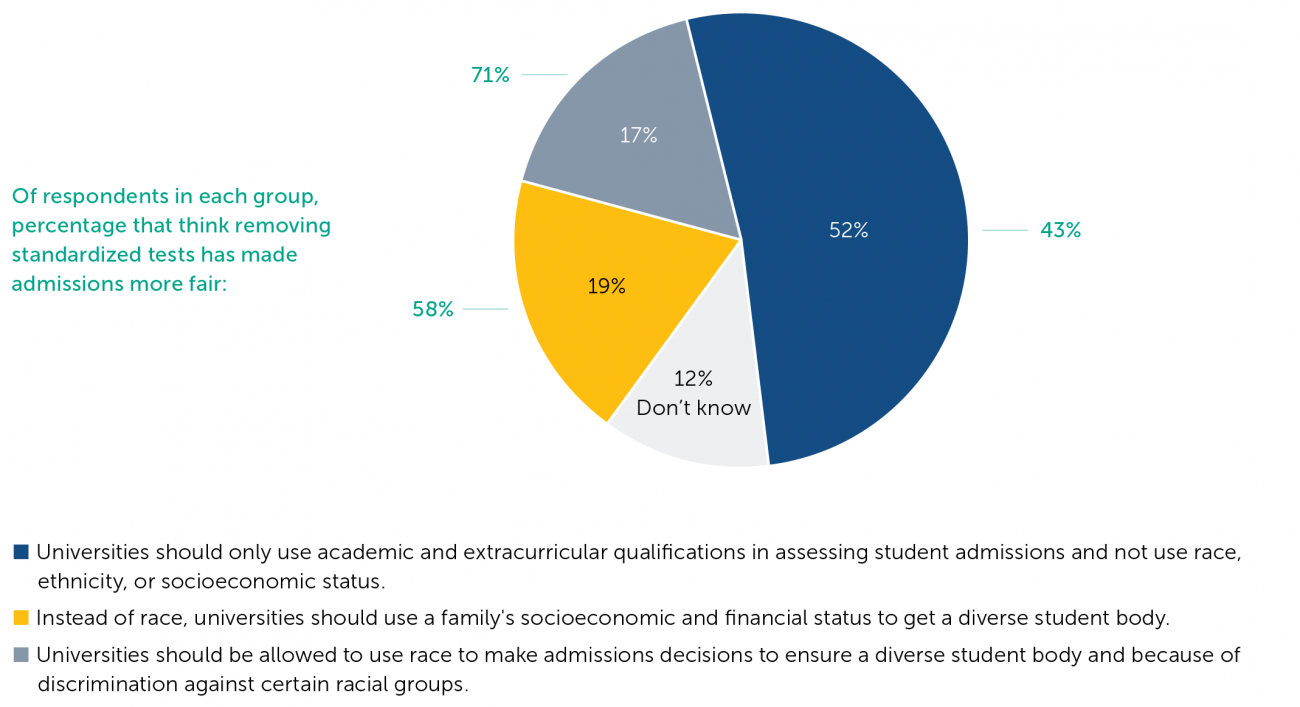
Conclusion
This brief examines the results from the annual 2021 PACE/USC Rossier poll with the goal of providing insight into Californians’ current perceptions about higher education issues, specifically around affordability, equity, and access. A large percentage of Californians acknowledge that college affordability is an important educational issue, and they generally express support for increased access to courses, funding, and more equitable admissions practices. Public opinion on these issues is more nuanced, suggesting that Californians are concerned that increased access to educational opportunities could compromise the quality of higher education. The majority of Californians support loan forgiveness but differ in the amounts that they believe should be forgiven. There are also differences in perception about these higher education issues across political affiliations and racial and ethnic groups. Understanding the nuances of these views through tools such as the PACE/USC Rossier poll helps identify what issues need to be addressed and reconciled so that leaders at all levels of the system can take meaningful action.
- 1Department of Education. (2021, January 26). Education in a pandemic: The disparate impacts of COVID-19 on America’s students. www2.ed.gov/about/offices/list/ocr/docs/20210608-impacts-of-covid19.pdf
- 2National Student Clearinghouse Research Center. (2021, June 10). Spring 2021 current term enrollment estimates. nscresearchcenter.org/current-term-enrollment-estimates
- 3California Community Colleges Chancellor’s Office. (2021). Vision for success spotlight: Laying the foundation for the post-COVID-19 recovery. go.boarddocs.com/ca/cccchan/Board.nsf/goto?open&id=BYS2LK02B713
- 4California Community Colleges Chancellor’s Office, 2021; Bulman, G., & Fairlie, R. W. (2021, June). The impact of COVID-19 on community college enrollment and student success: Evidence from California administrative data. National Bureau of Economic Research. nber.org/system/files/working_papers/w28715/w28715.pdf
- 5Burke, M., & Willis, D. J. (2021, April 12). California’s community colleges at critical crossroads as more students opt not to attend. EdSource. edsource.org/2021/californias-community-colleges-at-critical-crossroads-as-more-students-opt-not-to-attend/652637
- 6Setzer, R. (2021, May 24). The American Rescue Plan Act of 2021: A win for students and families. Education Trust West. edtrust.org/the-equity-line/the-american-rescue-plan-act-of-2021-a-win-for-students-and-families
- 7Campaign for College Opportunity. (2021, July 29). California higher education budget sets state on a path to recovery with equity. collegecampaign.org/wp-content/uploads/2021/07/July-2021-Final-Budget-Statement.pdf
- 8National Center for Fair and Open Testing. (2020, June 15). More than half of all U.S. four-years colleges and universities will be test-optional for fall 2021 admission. fairtest.org/more-half-all-us-fouryears-colleges-and-universiti
- 9Jaschik, S. (2021, August 9). Two-thirds of 4-year colleges will not require tests for admissions. Inside Higher Ed. insidehighered.com/admissions/article/2021/08/09/two-thirds-4-year-colleges-will-not-require-tests-admissions
- 10Gordon, L. (2020, May 21). In historic action, UC moves to drop SAT/ACT and develop a replacement exam for admission. EdSource. edsource.org/2020/in-historic-action-uc-moves-to-drop-sat-act-and-develop-a-replacement-exam-for-admissions/632174
- 11Full crosstabs for 2021 can be found at edpolicyinca.org/initiatives/pace-usc-rossier-annual-voter-poll/poll-archive; results by demographics for this question can be found starting on page 92 in the 2021 data file.
- 12This category refers to men and women, ages 50 and over.
- 13Hiler, T., & Erickson, L. (2019, June 17). Beyond free college and free markets: Voters want greater accountability in higher ed. Global Strategy Group for Third Way. thirdway.org/polling/beyond-free-college-and-free-markets-voters-want-greater-accountability-in-higher-ed
- 14Kurlaender, M. et al. (2018, December). Where California high school students attend college [Report]. Policy Analysis for California Education. edpolicyinca.org/publications/where-california-high-school-students-attend-college
- 15Campaign for College Opportunity. (2021, February). Follow the money: California systematically underinvests in Black degree attainment. collegecampaign.org/wp-content/uploads/2021/02/Follow-the-Money-8_5x11-Update.pdf
- 16Burke, M. (2021, July 22). Annual tuition increases coming to University of California. EdSource. edsource.org/2021/annual-tuition-increases-coming-to-university-of-california/658416
- 17Burke, M. (2021, October 8). Newsom vetoes bill that would have made major changes to Cal Grant program. EdSource. edsource.org/2021/newsom-vetoes-bill-that-would-make-major-changes-to-cal-grant-program/662193
- 18Rios-Aguilar, C., Kurlaender, M., Lyke, A., & Martinez, T. (2019, June). College affordability in every corner of California: Perspectives from the 2019 PACE/USC Rossier poll [Policy brief]. Policy Analysis for California Education. edpolicyinca.org/publications/college-affordability-california-perspectives-2019-pace-usc-rossier-poll
- 19Turner, C. (2021, October 6). What borrowers need to know about the Public Service Loan Forgiveness overhaul. NPR. npr.org/2021/10/06/1043332307/public-service-loan-forgiveness-education-department-overhaul
- 20Across all voters, 12 percent said “don’t know.” And among the 63 percent that supported loan forgiveness, the majority supported loan forgiveness at higher amounts: $11,000 or greater.
- 21Full crosstabs for 2021 can be found at edpolicyinca.org/initiatives/pace-usc-rossier-annual-voter-poll/poll-archive; results by demographics for this question can be found starting on page 328 in the 2021 data file.
- 22Snyder, T. D., De Brey, C., & Dillow, S. A. (2019). Digest of education statistics 2017 (NCES 2018-070). National Center for Education Statistics. files.eric.ed.gov/fulltext/ED592104.pdf
- 23Perry, A. M., Steinbaum, M., & Romer, C. (2021, July 12). Student loans, the racial wealth divide, and why we need full student debt cancellation. The Brookings Institute. brookings.edu/research/student-loans-the-racial-wealth-divide-and-why-we-need-full-student-debt-cancellation
- 24Kurlaender et al., 2018.
- 25California Community Colleges Chancellor’s Office. (n.d.). The California Promise. cccco.edu/About-Us/Chancellors-Office/Divisions/Educational-Services-and-Support/Student-Service/What-we-do/California-Promise
- 26Kurlaender et al., 2018.
- 27This question was asked as a split with different framing to assess whether voters’ preferences on support for students attending community college varied depending on whether the question was framed as addressing the fact that “enrollment in California’s community colleges has declined during the COVID-19 pandemic” versus “enrollment in California’s community colleges has declined during the pandemic, particularly for low-income students and students of color.” Responses were not substantively different across the two questions, so we combined them for reporting. Full results for each split can be found on the PACE website at edpolicyinca.org/initiatives/pace-usc-rossier-annual-voter-poll/poll-archive, starting on page 332 in the 2021 data file.
- 28Full crosstabs for 2021 can be found at edpolicyinca.org/initiatives/pace-usc-rossier-annual-voter-poll/poll-archive; results by demographics for this question can be found starting on page 319 in the 2021 data file.
- 29Shalby, C. (2021, June 4). Many CSU students see big upsides to online learning. Now, there is a push to expand it. Los Angeles Times. latimes.com/california/story/2021-06-04/covid-changes-csu-future-students-want-more-online-learning
- 30Gao, N., & Hayes, J. (2021, February). California’s digital divide. Public Policy Institute of California. ppic.org/publication/californias-digital-divide
- 31Reed, S. et al. (2021, June). California college students’ experiences during the global pandemic. California Student Aid Commission. csac.ca.gov/sites/main/files/file-attachments/fall_2020_covid19_student_survey_results_presentation.pdf
- 32Reed et al., 2021.
- 33Full crosstabs for 2021 can be found at edpolicyinca.org/initiatives/pace-usc-rossier-annual-voter-poll/poll-archive; results by demographics for this question can be found starting on page 330 in the 2021 data file.
- 34See full results for the 2019 survey here: edpolicyinca.org/initiatives/pace-usc-rossier-annual-voter-poll/poll-archive
- 35Full crosstabs for 2021 can be found at edpolicyinca.org/initiatives/pace-usc-rossier-annual-voter-poll/poll-archive; results by demographics for this question can be found starting on page 314 in the 2021 data file.
- 36These results were calculated using the weights of voter responses in the raw data set.
Martinez, M. N., Shin, G. H. R., Kurlaender, M., & Rios-Aguilar, C. (2021, December). Californians’ attitudes about college access, affordability, and equity in the time of COVID: Evidence from the 2021 PACE/USC Rossier annual poll [Policy brief]. Policy Analysis for California Education. https://edpolicyinca.org/publications/californians-attitudes-about-college-access-affordability-and-equity-time-covid-19



